If you’re serious about building a muscular, balanced upper body, vertical pull exercises need to be a staple in your training.
Contrary to popular belief, vertical pulls train much more than just your lats—they beef up your entire back, build your biceps, and can even help develop smaller upper body muscles like your shoulders, abs, and pecs.
Another misconception about vertical pulling exercises is that you need to do endless variations to make progress.
That’s tommyrot.
The truth is, if you stick to the right vertical back exercises, just a handful is enough to deliver outstanding gains. Here are my favorites:
- Pull-up
- Chin-up
- Neutral-grip pull-up
- Lat pulldown
- Close-grip lat pulldown
- Half-kneeling single-arm lat pulldown
- Cable pullover
In this article, you’ll learn why these vertical pulling exercises are so effective, how to perform them for maximum growth, and more.
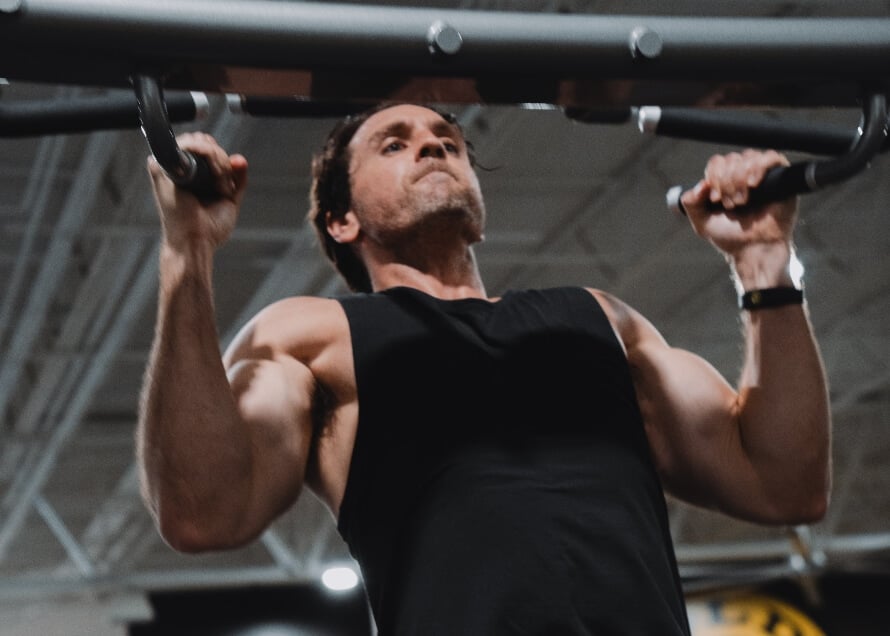
Table of Contents
+
What Are Vertical Pull Exercises?
A vertical pull exercise refers to any strength training movement where you pull against resistance in a “vertical plane” (up-and-down direction). This can involve pulling your body upward toward a bar, as in pull-ups, or pulling a weight downward, such as with the lat pulldown:
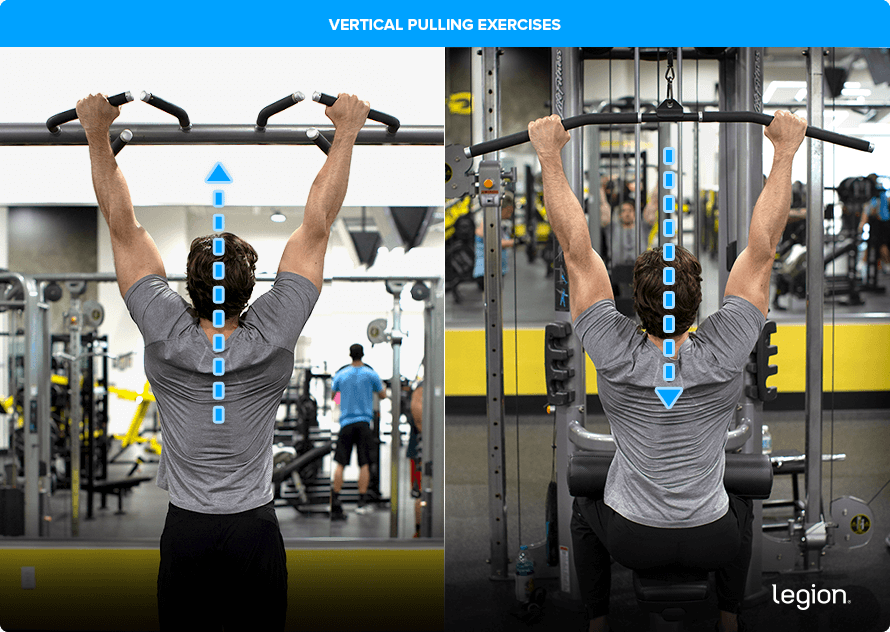
Muscles Worked by Vertical Pulling Exercises
The main muscles worked by vertical pulls are:
- Latissimus dorsi (lats)
- Trapezius (traps)
- Rhomboids
- Posterior deltoids (rear delts)
- Teres major and minor
- Infraspinatus
- Erector spinae
- Biceps
Here’s how these muscles look on your body:
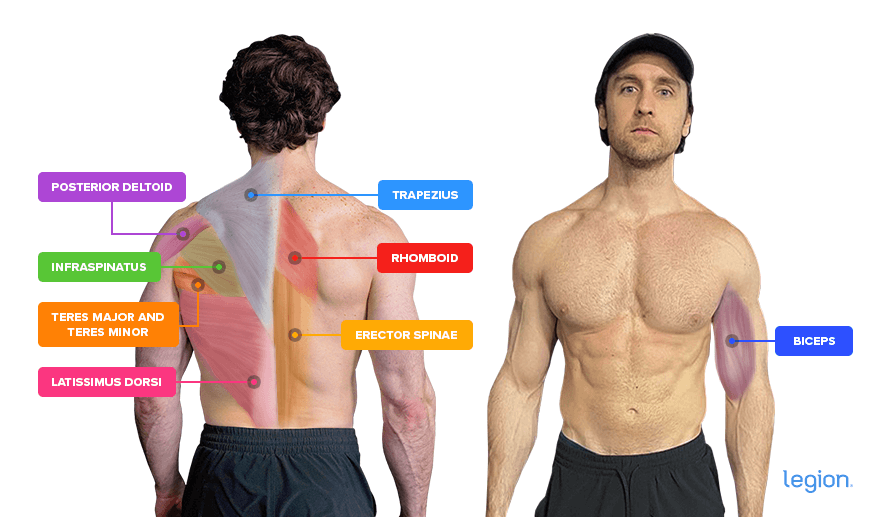
Basically, when you pull vertically, you train your entire back and biceps.
The Best Vertical Pull Exercise for Back & Biceps Mass
Although social media and fitness blogs offer up endless variations of vertical pulling exercises, only seven are truly worth your time.
These vertical pulls are superior because they’re easy to learn and perform, allow you to train with heavy weights safely, and make getting stronger over time straightforward.
In other words, these are the most effective vertical pull exercises for building back and biceps mass. Add them to your routine and watch how your physique changes.
1. Pull-up
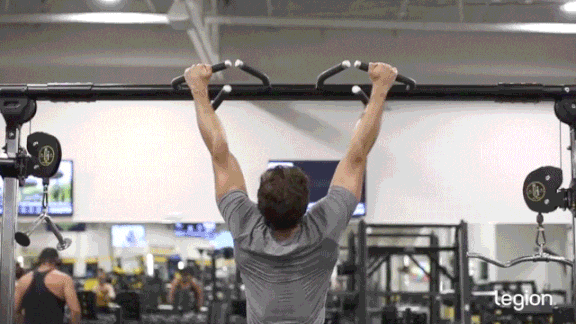
Why: The pull-up is the king of vertical pulling exercises because it trains your entire back and biceps, and even your abs and pecs to a small extent. When you use a dip belt, it also makes progressively overloading your back and biceps simple, so it’s ideal for gaining mass and strength.
How to:
- Grab a pull-up bar slightly wider than shoulder-width apart with your palms facing away from you.
- Lift your feet so that you’re hanging with your arms straight.
- Pull your body up until your chin is above the bar.
- Reverse the movement and return to the starting position.
2. Chin-up
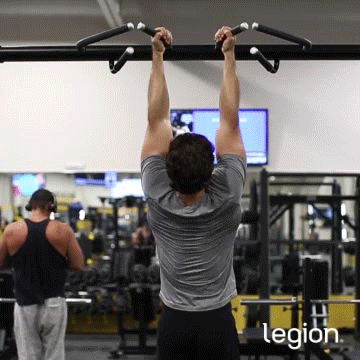
Why: The chin-up works your back much like the pull-up. However, because your palms face you, you train your biceps slightly more and your traps slightly less. These differences are minor, though, so you can more or less use the pull-up and chin-up interchangeably in your training.
How to:
- Grab a pull-up bar with your hands around shoulder-width apart and your palms facing toward you.
- Lift your feet so that you’re hanging with your arms straight.
- Pull your body up until your chin is above the bar.
- Reverse the movement and return to the starting position.
3. Neutral-Grip Pull-up
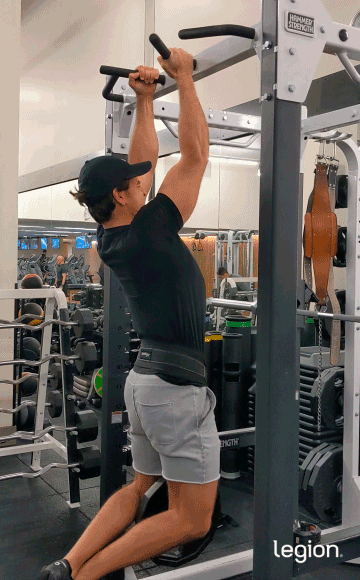
Why: The neutral-grip pull-up works your back similarly to the pull-up and chin-up. What sets it apart, though, is that it emphasizes the brachialis, a small muscle that adds significant mass to your biceps, which most other vertical pull exercises don’t target as effectively.
- Grab a neutral-grip pull-up bar with your hands around shoulder-width apart and your palms facing each other.
- Lift your feet so that you’re hanging with your arms straight.
- Pull your body up until your chin is above the bar.
- Reverse the movement and return to the starting position.
4. Lat Pulldown
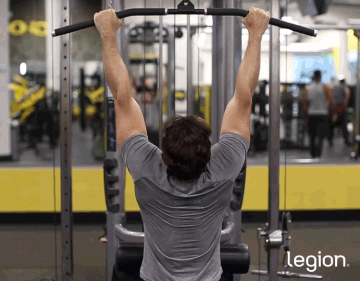
Why: The lat pulldown is an excellent vertical pull exercise for training your lats, biceps, and upper back, especially for beginners who struggle to do chin-ups and pull-ups.
How to:
- Adjust the thigh pad so that it locks your lower body in place.
- Stand up and grab the bar. While keeping your grip on the bar and your arms straight, sit down, allowing your body weight to pull the bar down with you.
- Nudge your thighs under the pads and plant your feet on the floor.
- Pull the bar to your chest.
- Reverse the movement and return to the starting position.
5. Close-Grip Lat Pulldown
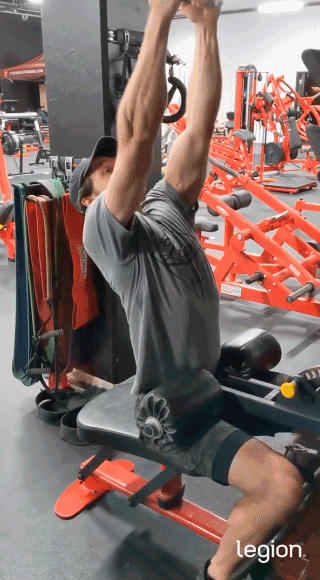
Why: The close-grip lat pulldown is an excellent exercise for training almost all the muscles of the back, including the lats, rhomboids, mid-traps, and rear deltoids. Because of the neutral-grip, some people also find it more comfortable on the wrists, elbows, and shoulders than other vertical back exercises.
How to:
- Attach a V-bar to the lat pulldown machine pulley.
- Adjust the thigh pad so that it locks your lower body in place.
- Stand up and grab the V-bar with your palms facing each other. While keeping your grip on the bar and your arms straight, sit down, allowing your body weight to pull the bar down with you.
- Nudge your thighs under the pads and plant your feet on the floor.
- Pull the bar to your chest.
- Reverse the movement and return to the starting position.
6. Half-Kneeling Single-Arm Lat Pulldown
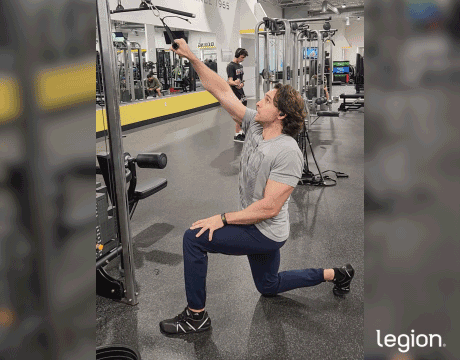
Why: The half-kneeling single-arm lat pulldown trains each side of your body independently, which makes it useful for finding and fixing muscle imbalances. Because you only have one side of your body to think about at a time, it can also help you establish a stronger “mind-muscle connection” than other vertical pulling exercises, which may help you gain more mass if you struggle to feel your back muscles working.
How to:
- Set the pulley to the highest position on a cable machine and attach the single D-handle.
- Grab the handle with your right hand, step back to support the weight, and kneel on your right knee with your left foot planted firmly on the floor.
- Pull the handle down to your right side at nipple height.
- Slowly reverse the movement and return to the starting position.
- Complete the desired reps, then switch to your left side.
7. Cable Pullover
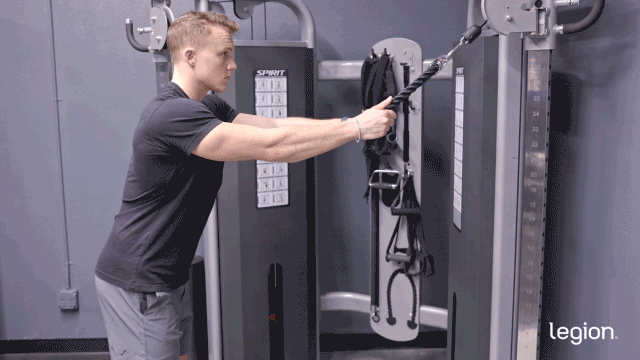
Why: The cable pullover trains your lats in a fully stretched position and through a long range of motion, which means it’s well-suited to adding mass and width to your back.
How to:
- Set the pulley to the highest position on a cable machine and attach the rope handle.
- Hold one end of the rope in each hand and step away from the pulley to support the weight.
- Lean forward until your body makes a 45-degree angle with the floor and your arms are nearly straight overhead.
- Position your feet shoulder-width apart and bend your knees slightly.
- Pull the rope in an arc toward your feet until your hands are by your thighs.
- Reverse the movement and return to the starting position.
The Benefits of Vertical Pull Exercises
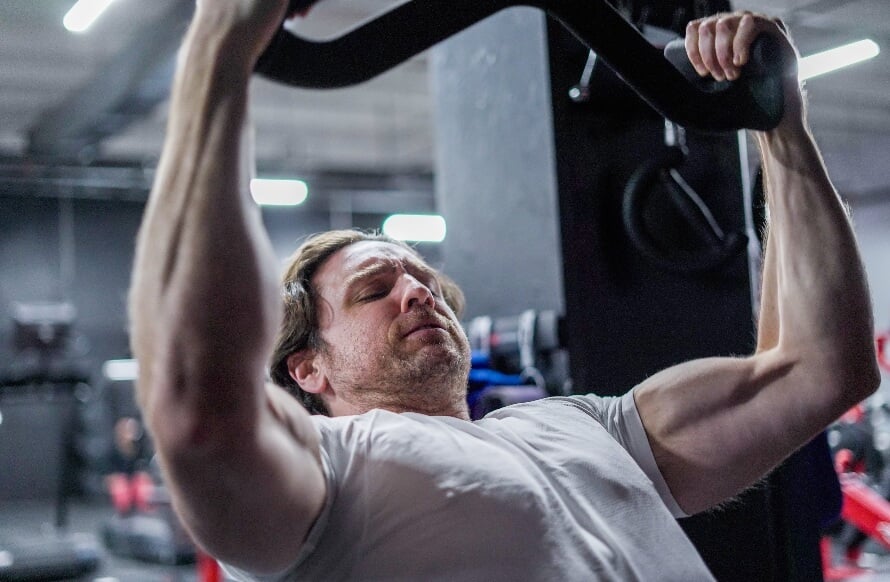
Upper Body Mass Gain
Contrary to popular belief, vertical pull exercises aren’t only good for adding back width—research shows they help you build back thickness, too.
Unlike horizontal pulling exercises, pulling vertically also trains your biceps to a high degree, and muscle groups like your pecs and abs to a lesser extent.
In other words, they’re perfect for adding mass to most of your upper body.
Functional Strength Development
Vertical pulling strength is essential for everyday activities, such as pulling yourself up off the floor, lifting yourself up to reach something above you, or climbing. Doing vertical back exercises strengthens the muscles involved in these movements, which makes them easier.
Improved Posture
People with poor posture often have weak back muscles. Strengthening them with vertical pulling exercises makes it easier to pull your shoulder blades together and prevents excessive shoulder rounding. This leads to better posture and can reduce strain on your shoulders and neck.
Vertical Pulling Exercises: Key Takeaways
Vertical pull exercises are essential for developing a muscular, strong, and balanced upper body.
While they primarily train your back and biceps, they also engage many smaller upper-body muscles, making them highly effective for gaining overall size and strength.
You don’t need countless variations to see results. In fact, the following seven vertical pull exercises are all you need to make impressive gains:
- Pull-up
- Chin-up
- Neutral-grip pull-up
- Lat pulldown
- Close-grip lat pulldown
- Half-kneeling single-arm lat pulldown
- Cable pullover
Add these vertical pull exercises to your routine today, and you’ll gain back and biceps mass and strength in no time.
FAQ #1: Can you do vertical pull exercises with dumbbells?
Dumbbells don’t lend themselves well to most vertical pull exercises. The dumbbell pullover is a partial exception, as it mimics the cable pullover, but it doesn’t fully fit into the category. Here’s how it looks:

Some argue that dumbbell upright rows and shrugs qualify as vertical pulls, but since vertical pulls typically target the lats, these exercises don’t quite fit, in my opinion.
Instead of trying to find novel ways to do vertical pull exercises with dumbbells, it’s more effective to focus on horizontal dumbbell pulling movements, which also target your back.
There are plenty of options, too. Just bear in mind that you’ll probably need to do more biceps volume (sets), since horizontal pulls don’t train your arms as much as vertical ones do.
FAQ #2: Can you do vertical pull exercises at home?
Yes, you can do vertical pull exercises at home, but your options are limited without a pull-up bar or resistance bands.
Pull-ups are the best option if you have a bar or something sturdy to hang from (an attic rafter, for example). If not, using resistance bands to mimic lat pulldowns is a solid alternative. Here’s how this looks:
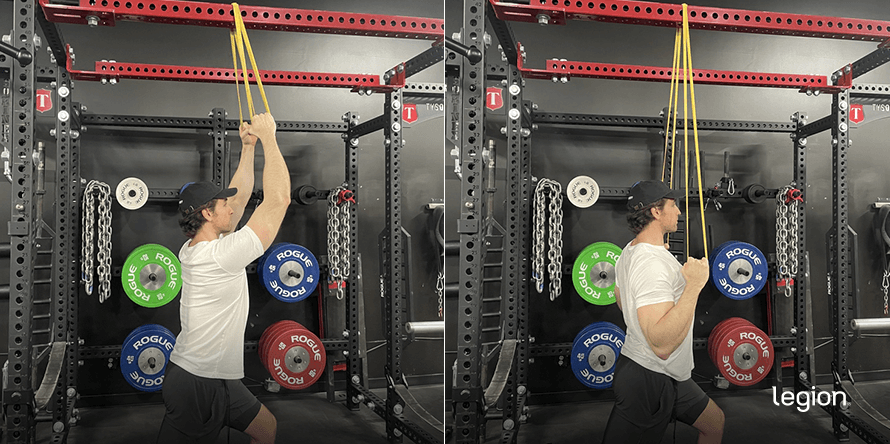
FAQ #3: Vertical pull vs. Horizontal pull: Which is better?
Neither is better or worse—they both train your entire back in slightly different ways:
- Vertical pulls with a shoulder-width grip train your back through shoulder adduction (moving your arms down toward your sides).
- Close-grip vertical and horizontal pulls emphasize shoulder extension (bringing your arms down in front of you).
- Horizontal pulls with a wide grip emphasize shoulder transverse abduction (moving your upper arms out to the sides) and scapular retraction (pulling your shoulder blades together).
This is significant because training your muscles through different ranges of motion and at varying angles produces more balanced growth than using less variety.
In other words, framing it as “vertical pulls vs. horizontal pulls” isn’t that useful. The best approach is to include both in your training.
This is the strategy I use in my own workout routine and the programs in my fitness books for men and women, as it’s the most effective way to build a well-rounded back.
FAQ #4: Are vertical pulling exercises bad for your shoulders?
No, vertical pulling exercises aren’t bad for your shoulders as long as you use good technique. To avoid shoulder discomfort, focus on using proper form and steer clear of “ego lifting”—lifting weights that are too heavy for you to control. Instead, choose weights you can handle with good form, and you’ll minimize the risk of injury.
FAQ #5: Is a deadlift a vertical pull?
No, a deadlift isn’t a vertical pull—it’s a “hip hinge”. In other words, it involves lifting a weight by hinging and extending your hips rather than pulling in an up-and-down direction.
Scientific References +
- Youdas, James W, et al. “Surface Electromyographic Activation Patterns and Elbow Joint Motion during a Pull-Up, Chin-Up, or Perfect-PullupTM Rotational Exercise.” Journal of Strength and Conditioning Research, vol. 24, no. 12, Dec. 2010, pp. 3404–3414, https://doi.org/10.1519/jsc.0b013e3181f1598c.
- Dickie, James A., et al. “Electromyographic Analysis of Muscle Activation during Pull-up Variations.” Journal of Electromyography and Kinesiology, vol. 32, Feb. 2017, pp. 30–36, https://doi.org/10.1016/j.jelekin.2016.11.004. Accessed 9 Aug. 2019.
- Signorile, Joseph F., et al. “A Comparative Electromyographical Investigation of Muscle Utilization Patterns Using Various Hand Positions during the Lat Pull-Down.” Journal of Strength and Conditioning Research, vol. 16, no. 4, 1 Nov. 2002, pp. 539–546, pubmed.ncbi.nlm.nih.gov/12423182/.
- Lusk, Stephen J, et al. “Grip Width and Forearm Orientation Effects on Muscle Activity during the Lat Pull-Down.” Journal of Strength and Conditioning Research, vol. 24, no. 7, July 2010, pp. 1895–1900, https://doi.org/10.1519/jsc.0b013e3181ddb0ab.
- Park, Se-yeon, and Won-gyu Yoo. “Differential Activation of Parts of the Latissimus Dorsi with Various Isometric Shoulder Exercises.” Journal of Electromyography and Kinesiology, vol. 24, no. 2, Apr. 2014, pp. 253–257, https://doi.org/10.1016/j.jelekin.2013.12.004.
- Gerling, Michael E., and Stephen H. M. Brown. “Architectural Analysis and Predicted Functional Capability of the Human Latissimus Dorsi Muscle.” Journal of Anatomy, vol. 223, no. 2, 13 June 2013, pp. 112–122, https://doi.org/10.1111/joa.12074.
- Oranchuk, Dustin J., et al. “Isometric Training and Long-Term Adaptations: Effects of Muscle Length, Intensity, and Intent: A Systematic Review.” Scandinavian Journal of Medicine & Science in Sports, vol. 29, no. 4, 13 Jan. 2019, pp. 484–503, onlinelibrary.wiley.com/doi/full/10.1111/sms.13375, https://doi.org/10.1111/sms.13375.
- Andersen, Vidar, et al. “Effects of Grip Width on Muscle Strength and Activation in the Lat Pull-Down.” Journal of Strength and Conditioning Research, vol. 28, no. 4, Apr. 2014, pp. 1135–1142, https://doi.org/10.1097/jsc.0000000000000232.
- Wolf, Milo, et al. Partial vs Full Range of Motion Resistance Training. 24 Sept. 2022, https://doi.org/10.51224/srxiv.198. Accessed 1 May 2024.
- Costa, Bruna Daniella de Vasconcelos, et al. “Does Performing Different Resistance Exercises for the Same Muscle Group Induce Non-Homogeneous Hypertrophy?” International Journal of Sports Medicine, vol. 42, no. 09, 13 Jan. 2021, pp. 803–811, https://doi.org/10.1055/a-1308-3674.










